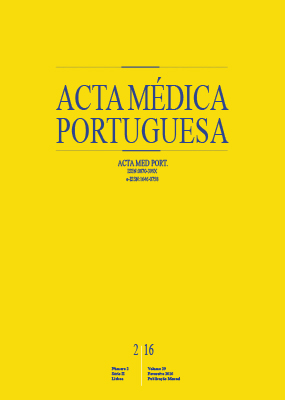Avanços Cirúrgicos Recentes na Doença de Peyronie
DOI:
https://doi.org/10.20344/amp.6317Palavras-chave:
Induração Peniana, Pénis/cirurgia, Procedimentos Cirúrgicos Urológicos Masculinos, Prótese de Pénis.Resumo
Introdução: A doença de Peyronie, uma doença fibrótica da túnica albuginea do pénis tem estado associada a encurtamento peniano e a algum grau de disfunção eréctil. Afeta a qualidade de vida do doente, levando a stress psicológico, mental e físico. A deformidade peniana perturba a vida sexual do doente, levando a episódios de depressão, disfunções sexuais e a ansiedade associada ao ato sexual. A etiologia da doença de Peyronie permanece por esclarecer.
Material e Métodos: A pesquisa na literatura foi efetuada nas bases de dados da Medline, Embase e Cochrane no mês de Janeiro de 2015 no sentido de identificar artigos relacionados com a doença de Peyronie, nomeadamente o tratamento cirúrgico, técnicas, resultados bem como tratamentos complementares. Publicações que não envolvessem humanos não foram consideradas. Identificámos artigos originais, artigos de revisão e editoriais acerca do assunto em questão. Todos os artigos publicados na língua inglesa foram selecionados para screening. Os critérios de elegibilidade para inclusão envolveram a relevância associada ao tema.
Resultados: Existe uma variedade de deformidades penianas associada com a doença de Peyronie que ainda não têm uma solução não cirúrgica que seja eficaz. Apresentamos uma atualização das técnicas cirúrgicas atuais bem como o algoritmo de tratamento associada a esta doença.
Discussão: Todos os tratamentos cirúrgicos têm como objetivo a correção da curvatura, a preservação da função eréctil e do comprimento peniano, bem como o de minimizar a morbilidade.
Conclusão: Até à data não existem estudos de medicina baseada na evidência que determinem o melhor tratamento cirúrgico para a doença de Peyronie. Após o diagnóstico, a reconstrução cirúrgica deve ter como objetivo um pénis funcional, com uma retificação da sua curvatura que permita o acto sexual.
Downloads
Downloads
Publicado
Como Citar
Edição
Secção
Licença
Todos os artigos publicados na AMP são de acesso aberto e cumprem os requisitos das agências de financiamento ou instituições académicas. Relativamente à utilização por terceiros a AMP rege-se pelos termos da licença Creative Commons ‘Atribuição – Uso Não-Comercial – (CC-BY-NC)’.
É da responsabilidade do autor obter permissão para reproduzir figuras, tabelas, etc., de outras publicações. Após a aceitação de um artigo, os autores serão convidados a preencher uma “Declaração de Responsabilidade Autoral e Partilha de Direitos de Autor “(http://www.actamedicaportuguesa.com/info/AMP-NormasPublicacao.pdf) e a “Declaração de Potenciais Conflitos de Interesse” (http://www.icmje.org/conflicts-of-interest) do ICMJE. Será enviado um e-mail ao autor correspondente, confirmando a receção do manuscrito.
Após a publicação, os autores ficam autorizados a disponibilizar os seus artigos em repositórios das suas instituições de origem, desde que mencionem sempre onde foram publicados e de acordo com a licença Creative Commons









